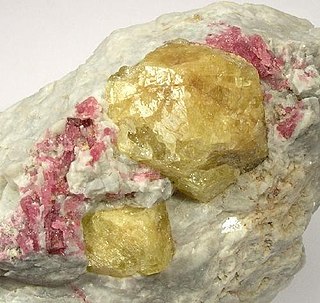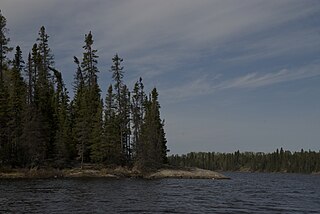
Oedura is a genus of medium to large geckos, lizards in the family Diplodactylidae. The genus is endemic to Australia. Species in the genus are referred to by the common name velvet geckos.

Neso, also known as Neptune XIII, is the outermost known natural satellite of Neptune. It is an irregular moon discovered by Matthew J. Holman, Brett J. Gladman, et al. on August 14, 2002, though it went unnoticed until 2003. Neso orbits Neptune at a distance of more than 48 Gm, making it the most distant known moon of any planet. At apocenter, the satellite is more than 72 Gm from Neptune. This distance is great enough to exceed Mercury's aphelion, which is approximately 70 Gm from the Sun.

The borate minerals are minerals which contain a borate anion group. The borate (BO3) units may be polymerised similar to the SiO4 unit of the silicate mineral class. This results in B2O5, B3O6, B2O4 anions as well as more complex structures which include hydroxide or halogen anions. The [B(O,OH)4]− anion exists as well.

http://www.sicily.co.uk/wp-content/uploads/Naso-DWKCKW.jpg

The Diplodactylidae are a family in the suborder Gekkota (geckos), with about 137 species in 25 genera. These geckos occur in Australia, New Zealand, and New Caledonia. Three diplodactylid genera have recently been split into multiple new genera

Ceratinia neso, the Neso tigerwing, is a species of butterfly of the family Nymphalidae. It is found in South America.

Neso Lake is a glacial lake on the Mistik Creek chain in the Hudson Bay drainage basin in the Northern Region of Manitoba, Canada. It sits in the Churchill River Upland portion of the Midwestern Canadian Shield forests which consist of mixed coniferous forest trees. The region around the lake consists of rocky parallel ridges with poorly drained areas of muskeg and irregular rocky shorelines due to intense glaciation. The lake is situated on the well known "Mistik Creek Loop", a remote canoe route which is 95 km (59 mi) in total length can be paddled in four days.

Amalosia is a genus of lizards in the family Diplodactylidae endemic to Australia. It includes four species: All species of this genus were previously included with the genus Oedura until 2012, when Oliver et al. transferred four species to this genus and erected two new monotypic genera, Hesperoedura for Oedura reticulata and Nebulifera for Oedura robusta Some taxonomic authorities still place all four species in the former genus. All species are native to Australia.
Amalosia jacovae, also known as the clouded gecko, is a species of gecko, a lizard in the family Diplodactylidae. The species is endemic to Australia.
The northern velvet gecko is a species of gecko, a lizard in the family Diplodactylidae. The species is endemic to Queensland in Australia.

Oedura coggeri, commonly known as the northern spotted velvet gecko, is a species of gecko, a lizard in the family Diplodactylidae. The species is endemic to Queensland, Australia.
Oedura luritja, also called the Mereenie velvet gecko, is a species of geckos endemic to the Northern Territory of Australia.
The marbled velvet gecko is a gecko endemic to Australia.
Oedura murrumanu, also called the limestone range velvet gecko, is a gecko endemic to Australia.

The southern spotted velvet gecko, also known commonly as Tryon's velvet gecko, is a species of lizard in the family Diplodactylidae. The species is endemic to Australia.
Nasos was a town and polis (city-state) of ancient Aeolis. The place-name "Nesos Pordoselene" appears in the list of tributes to ancient Athens of the year 422/1 BCE but there are different opinions on whether Nesos and Pordoselene were a single city or if they are two different cities. On the other hand, the nickname "nasiotas" (Νασιώτας) appears in an inscription of Adramyttium dated to 319-317 BCE.
Pordoselene or Poroselene (Ποροσελήνη) was a town and polis (city-state) of ancient Aeolis. It was located on the chief island of the Hecatonnesi, a group of small islands lying between Lesbos and the coast of Asia Minor, which was also called Prodoselene. Strabo says that some, in order to avoid the dirty allusion presented by this name, called it Poroselene, which is the form employed by Ptolemy, Pliny the Elder, and Aelian. At a still later time the name was changed into Proselene, under which form the town appears as a bishop's see. Aristotle mentions the town in his History of Animals where it was on the extremity of a road that formed the border between an area of the island that contained weasels and another area that did not have them.
Oedura picta, the ornate velvet gecko, is a species of gecko endemic to Queensland in Australia. It, along with two other species, was first formally named in 2019.
Oedura lineata, the Arcadia velvet gecko, is a species of gecko endemic to Queensland in Australia. It, along with two other species, was first formally named in 2019.
Oedura elegans, the elegant velvet gecko, is a species of gecko endemic to Queensland and New South Wales in Australia. It, along with two other species, was first formally named in 2019.








